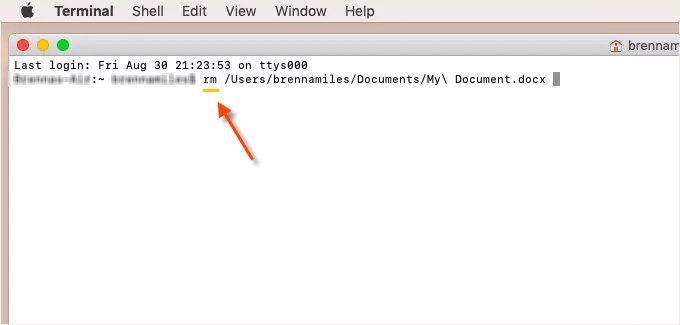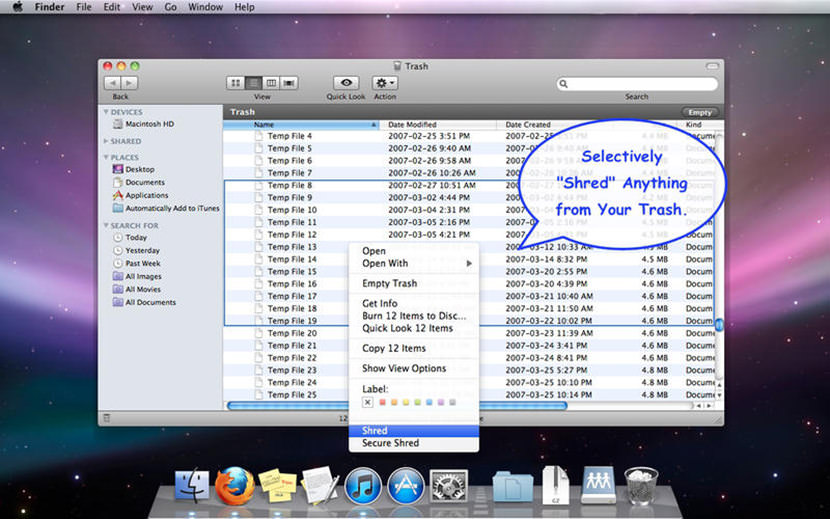

- #Mac os permanently delete file how to
- #Mac os permanently delete file install
- #Mac os permanently delete file windows 10
- #Mac os permanently delete file portable
- #Mac os permanently delete file software
You’ll still see the file in the OneDrive folder on your computer, but it will take up zero hard drive space.ĭelete from both your OneDrive and your hard drive If you want to keep a file, photo, or folder on your OneDrive, but not on your computer (because you don’t want it to take up space), put the file in your OneDrive folder, then turn on Files On-Demand (Windows) (or Files On-Demand (Mac)). Your files should disappear from the Mac Finder, and assuming you have your volume turned on, you’ll hear the familiar crunching noise of the files going into the Trash. Press the command delete keyboard keys at the same time. If you want to keep a file, photo, or folder on your computer, but not on OneDrive, use File Explorer (or Mac Finder, if you're on a Mac) to move the file outside your OneDrive folder to a different folder on your hard drive.ĭelete from your hard drive but not your OneDrive The solution: Select the files and/or folders you want to delete in the Finder, then. Delete items from your OneDrive, your hard drive, or bothĭelete from your OneDrive but not your hard drive Now click Turn On FileVault.Note: Once you delete files from the OneDrive recycle bin, there may be a short delay in seeing that reflected in your OneDrive account's storage availability.
#Mac os permanently delete file install
Note: To set up FileVault, click the Apple menu and select System Preferences. To permanently delete files on Mac hard drive by using BitRaser for File, follow these simple steps: Install and launch ‘ BitRaser for File ’ on your Mac Click on the gear icon at the top to choose ‘ Settings ’ Choose a data erasure algorithm, verification method, and Certificate Path from the respective drop-down lists and click ‘ OK. Similar to BitLocker, it helps prevent unauthorized access to your data and adds an extra layer of security in case your computer is stolen or lost. Macs have their own built-in disk-encrypting tool, too, called FileVault. Users of Home versions of Windows 7, 8.1 and 10 can use the free and open-source encryption tool VeraCrypt.
#Mac os permanently delete file windows 10
BitLocker is available to anyone with a machine running Windows Vista or 7 Ultimate, Windows Vista or 7 Enterprise, Windows 8.1 Pro, Windows 8.1 Enterprise, or Windows 10 Pro. PC users can enable Windows’ built-in encryption tool BitLocker. With encryption, your data will be converted into an unreadable code that can only be deciphered with a specific key or password. Hard drive encryptionĪn extra layer of security you can employ is disk encryption. You can also just employ a keyboard shortcut. You will still need to confirm you want to delete the items with the resulting dialog. Normally, it will say Move to Trash but if you hold down the Option the selection will change to Delete Immediately. In case you didn’t know, the popular cross-platform tool CCleaner for PCs and Macs not only does automatic clean-up of your browser cookies, trackers, internet history, download history, cache and even individual session activity it also has an option for Secure Deletion of files. You select them and then click the File menu. However, it does cost $49.99 to download. To shred files you’d like to remove from Macs, you’ll need to use a shredding app like High Secure Shredder for Mac. When macOS Sierra was released, Apple removed the secure delete option for both the Trash Can and the Terminal.

It “shreds” files by overwriting the data with zeros before deleting, making recovery impossible.

#Mac os permanently delete file portable
You can even schedule deletions to happen automatically.īlank and Secure is a portable deletion tool that you can store on a USB stick. It has a simple, clean interface, and can permanently erase data from any drive that works with Windows.

#Mac os permanently delete file software
You get can rid of that personal data by using software tools like Eraser or Blank and Secure for Windows.Įraser, in particular, has a lot of options for deleting data. If you want to get serious about your personal security, you need to erase sensitive data for good. Note: You can also enter the file’s path into. Who wants that? Erasing your data forever Type rm and space, and then drag and drop the file (s) you want to get rid of permanently into the Terminal window. You could be turning over your entire digital life to a stranger.
#Mac os permanently delete file how to
If everything worked correctly the file should disappear How to delete a service you previously created: This should come handy should you decide to delete a service as there is no option in Automator to delete a service. And just think about that old computer you’re going to sell on eBay. Right-click and choose Permanently Delete file.


 0 kommentar(er)
0 kommentar(er)
